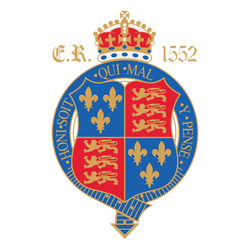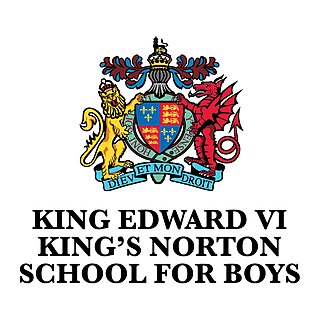
King Edward VI Grammar School, or KEGS, is a British grammar school with academy status located in the city of Chelmsford, Essex, England. It takes pupils between the ages of 11 and 18, ie. school years 7 to 13. For years 7 to 11 the school is boys-only, whereas it is mixed in the sixth form. The headteacher is Tom Carter, who was appointed in the autumn of 2014.
King Edward's School or King Edward VI School may refer to:

King Edward's School (KES) is an independent day school for boys in the British public school tradition, located in Edgbaston, Birmingham. Founded by King Edward VI in 1552, it is part of the Foundation of the Schools of King Edward VI. It is a member of the Headmasters' and Headmistresses' Conference.

The Royal Grammar School, Guildford, also known as the RGS, is a selective private day school for boys in Guildford, Surrey in England. The school dates its founding to the death of Robert Beckingham in 1509 who left provision in his will to 'make a free scole at the Towne of Guldford'; in 1512 a governing body was set up to form the school. The school moved to the present site in the upper High Street after the granting of a royal charter from King Edward VI in 1552. Around that time, its pupils were playing cricket and their activity was later documented as the earliest definite reference to the sport. The school's Old Building, constructed between 1557 and 1586, is the home of a rare example of a chained library. It was established on the death of John Parkhurst, Bishop of Norwich, in 1575. Although defined as a 'free' school, the first statutes of governance, approved in 1608, saw the introduction of school fees, at the rate of 4 shillings per annum, along with the school's first admissions test. During the late 19th century the school ran into financial difficulty, which nearly resulted in its closure. A number of rescue options were explored, including amalgamation with Archbishop Abbott's School. Funds were eventually raised, however, which allowed the school to remain open, although boarding was no longer offered.

King Edward VI Aston School is a selective, all-boys grammar school and specialist sports college. The school, designed by Birmingham architect J.A. Chatwin, opened in 1883 and is still, with additional buildings, located on its original site, in the Aston area of Birmingham, England. King Edward VI Aston Grammar School does not charge tuition fees; pupils must pass an 11-plus entrance exam to get into the school. The King Edward Schools are fiercely competitive to get admission to. The King Edward VI Foundation holds its exams at the same time, and generally, a candidiate will sit one exam for multiple schools within the foundation.

King Edward VI Five Ways (KEFW) is a selective co-educational state grammar school for ages 11–18 in Bartley Green, Birmingham, United Kingdom. One of the seven establishments of the Foundation of the Schools of King Edward VI, it is a voluntary aided school, with admission by highly selective examination. It was founded in Five Ways, Birmingham in 1883 and retained its name when it moved to Bartley Green in 1958.

King Edward VI Handsworth School is a grammar school for girls aged 11–18 located in Handsworth, Birmingham, England. It is part of the Foundation of the Schools of King Edward VI. The school was founded in 1883 as King Edward's Aston on the site where its brother school, King Edward VI Aston School, remains to this day. In 2019 there were 1086 girls on roll. Pupils must pass an 11-plus entrance exam to get into the school. The King Edward Schools are fiercely competitive to get admission to, as only 1 in 10 are successful in passing the entrance exam. The King Edward VI Foundation holds its exams at the same time, and generally a candidate will sit one exam for multiple schools within the foundation. Notable leaver's destinations from this school in previous years have been Birmingham, Aston, Oxford, and Nottingham. The leavers destinations by course were mainly medicine, dentistry, law, business studies and computer science.

The King Edward VI Foundation Birmingham is a charitable institution that operates thirteen schools in Birmingham, England.

King Edward VI College (KEDST) is a selective state sixth form centre located in Stourbridge, England, in the West Midlands area.

Lady Manners School is an English secondary school located in Bakewell, a market town in the Peak District National Park, Derbyshire. It was founded on 20 May 1636 by Grace, Lady Manners, who lived at Haddon Hall, the current home of Lord and Lady Edward Manners, and has also in the past been known as the Bakewell Grammar School. It is now a member of the Peak 11 group of secondary schools in the Peak District.

Ermysted's Grammar School is an 11-18 boys' voluntary aided grammar school in Skipton, North Yorkshire, England.

King Edward VI Camp Hill School for Girls, also known as Camp Hill Girls, is a selective grammar school in Kings Heath, Birmingham, for students aged 11 to 18. It is one of the most academically successful schools in the United Kingdom, currently ranked 10th among state schools. It is one of seven schools in Birmingham that are part of the King Edward VI Foundation. It shares a campus with King Edward VI Camp Hill School for Boys and, in 1958, both schools moved from their original location in central Birmingham to Vicarage Road in the Birmingham suburb of Kings Heath. The buildings are connected and some facilities and activities are shared, but they are separate establishments. The name has been retained from the school's former site at Camp Hill.
King Edward VI School, Lichfield, is a co-educational comprehensive secondary school and sixth form located near the heart of the city of Lichfield, Staffordshire, England. It is a community school maintained by Staffordshire Education Authority and admits pupils from the age of 11, with most electing to continue their education into the sixth form, leaving at 18. In the main school, the published admissions number is 250 pupils for each year group. In total there are in excess of 1600 pupils on roll.
King Edward VI School is a co-educational comprehensive secondary school in Bury St Edmunds, Suffolk, England. The school in its present form was created in 1972 by the merging of King Edward VI Grammar School, with the Silver Jubilee Girls School and the Silver Jubilee Boys School. The school occupies the site of the former Silver Jubilee schools in Grove Road, Bury St Edmunds.
King Edward VI High School is a coeducational secondary school and sixth form located in the Highfields area of Stafford, England. The school's sixth form forms part of the Stafford Collegiate. It is a non-selective state school admitting boys and girls from ages 11–18. The school was formed in 1977 following the amalgamation of King Edward VI Boys’ Grammar School and Stafford Girls’ High School.
Bournville School is an all-through school and primary school with academy status, for students aged 4–16, in Bournville, Birmingham in the United Kingdom. The school has around 850 pupils currently on the roll, including a primary provision of around 150 students. The school became an Academy School on 1 November 2014 under the sponsorship of The Fairfax Multi Academy Trust (FMAT). Fairfax Academy is also in the same MAT.
King Edward VI Camp Hill School may refer to:

King Edward VI King’s Norton School for Boys, is a secondary school for around 800 pupils aged 11 to 16. It is located in Northfield Road in Kings Norton within the formal district of Northfield near the centre of the city of Birmingham, England. It is situated east of the A441, just north of the B4121 in Cotteridge.
King Edward VI Sheldon Heath Academy is a mixed secondary school and sixth form located in the Sheldon area of Birmingham, in the West Midlands of England.













